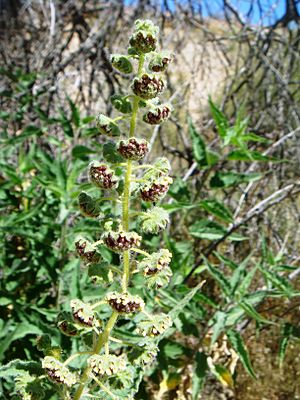Canyon ragweed facts for kids
Ambrosia ambrosioides, also known as canyon ragweed or chicura, is a type of ragweed plant. You can find it growing in the deserts of northern Mexico (including Baja California, Baja California Sur, Chihuahua, Durango, and Sonora) and in parts of the United States (like Arizona and California, especially in Ventura and San Diego Counties).
Quick facts for kids Canyon ragweed |
|
|---|---|
 |
|
| South Mountain, Phoenix, Arizona | |
| Scientific classification | |
| Genus: |
Ambrosia
|
| Species: |
ambrosioides
|
| Synonyms | |
|
|
What Does it Look Like?
This plant grows like a shrub, usually about 1 to 2 meters (3 to 6 feet) tall. Its leaves are long and have rough, jagged edges. They can be from 4 to 18 centimeters (about 1.5 to 7 inches) long and 1.5 to 4 centimeters (about 0.6 to 1.5 inches) wide.
Ambrosia ambrosioides has both male and female flowers on the same plant. The male flowers grow in clusters above the female flowers. This plant usually blooms from February to April. After flowering, it produces fruits that are like small burs, about 10 to 15 millimeters (0.4 to 0.6 inches) long. These burs are covered with tiny, hooked spines.
Where Does it Grow?
You can often find canyon ragweed in sandy areas, especially in dry riverbeds called washes. It also likes to grow in places where the ground has been disturbed, such as along roadsides. Sometimes, you might even see it growing out of cracks in rocks.
How People Used It
The Seri people, who live in parts of Mexico, used this plant in interesting ways. They would smoke the dried leaves of the plant. They also used the roots to make special teas for medicine and to create pigments, which are natural colors.
See also
 In Spanish: Chicura para niños
In Spanish: Chicura para niños

